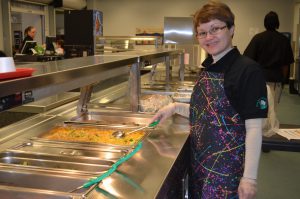
Originally posted in September 2013
Yesterday, I asked my third grade son, who buys his meal in the cafeteria at Sterling School every day, what he chose to eat for lunch.
“I got the hummus plate,” he replied.
“The hummus plate?” I asked, surprised. “How was it?”
He shrugged. “It was pretty good.”
I don’t want to misrepresent my son as someone with a wildly adventurous palate. This is a kid who begs me to purchase the bright variety packs of cereals when we go to the grocery store and who is easily wooed by a fast food joint based on what movie character is hawking it on Nickelodeon. I do believe he’s less picky than most children; however, he will let me know when “too many things are touching” in a casserole I’ve made or if nose-plugging is necessary for vegetables that are “weird.”
So the fact that he will eat a hummus plate without fanfare (as well as carrot-ginger soup, veggie quesadillas, and enchilada pie) is a big victory for me.
And thousands of parents in Greenville County’s 51 elementary schools are having the same victories each day.
It’s been widely reported that Greenville County Schools Food and Nutrition Services has developed Culinary Creations menus in its elementary cafeterias. Funded by the Piedmont Health Foundation, along with Blue Cross Blue Shield of SC, Greenville Women Giving, and others, Greenville County Schools’ food service workers participated in culinary training at Greenville Tech’s Culinary Institute of the Carolinas. This has enabled them to offer fresh salads, scratch made soups, whole grains, local produce, and vegetarian entrees each and every day. And thanks to the culinary training, the food is attractively presented and nicely seasoned.
Critics have speculated that students just won’t eat the healthier menu items, suggesting that kids like only corn dogs and chicken nuggets. However, sales show that many students have more adventurous taste preferences than grownups give them credit for. In fact, at most schools, sales have held steady or increased with the new Culinary Creations items.
A blog by Patrick Mustain on ScientificAmerican.com describes both the research and health imperatives behind testing assumptions about what kids will and won’t eat (It Is Not True that Kids Won’t Eat Healthy Food: Why the New USDA School Guidelines Are Very Necessary). Mustian writes, “A number of studies show that neophobia (the fear of trying new foods) can be unlearned through exposure to a variety of novel foods, even just visual exposure. However, in the current food environment, many children are offered, or have an option to seek out, hyper-palatable, energy dense, nutritionally lacking foods. This lack of exposure to a variety of novel foods keeps their level of pickiness high. Picky eating is (generally) not an inherent trait, they are simply responding naturally to an environment that has never challenged their palate.”
To his point, it is noteworthy that some of the strongest lunchroom participation trends in Greenville County are in those schools with the highest Free and Reduced lunch rates. These are the students who eat school lunch because their families are less able to afford sending a lunch packed at home. In other words, they have no choice other than to eat whatever is served at school, be it a corn dog or, as is the case in Greenville County, a veggie burger and salad. And by and large, the students are eating these healthy foods. Cafeterias are finding that, across the district, there is not more food waste than before the menu changes were implemented (in other words, kids have always thrown away some of their lunch because they are full, spent too much time talking to friends to eat, or they just don’t want a particular item on the tray).
This is significant – it means that those children who aren’t given the opportunity to be picky (“my daughter doesn’t like what’s on the menu today, so I’m going to pack her a peanut butter and jelly sandwich and chips”) will find things that they can, in fact, eat. And when those things are fruits, vegetables, whole grains, and lean proteins – especially for kids who are from food-poor homes – it’s a big deal from a public health perspective.
Do these kids love everything they try? No. I wish my son had loved the school hummus plate, as I do, and perhaps he won’t order it again. But maybe he will give it another chance. Because his school has been a few steps ahead of the new USDA guidelines, he’ll be able to test this and lots of other tasty, healthy foods the whole school year long. I just need to stay out of the way and let him do it.
